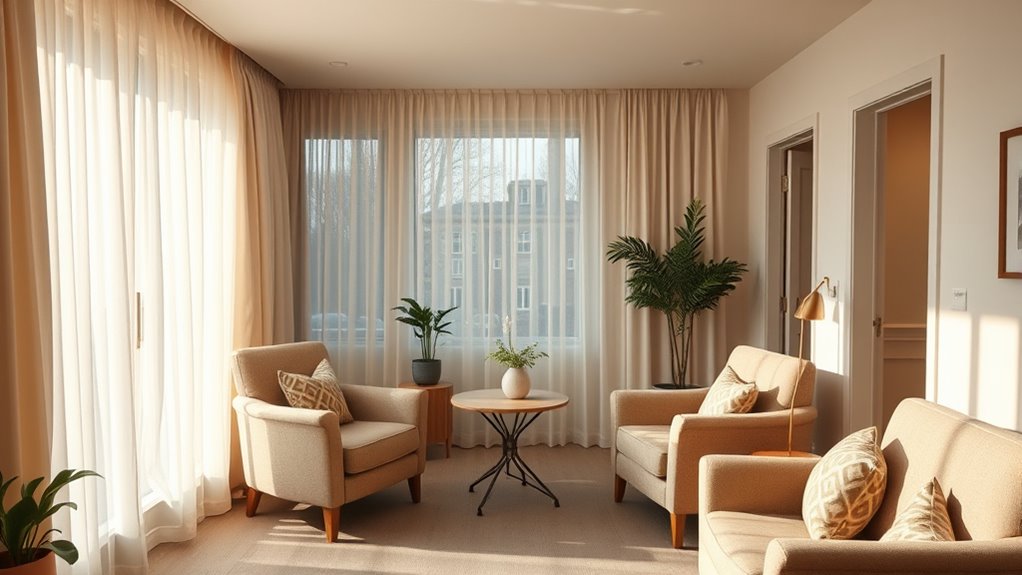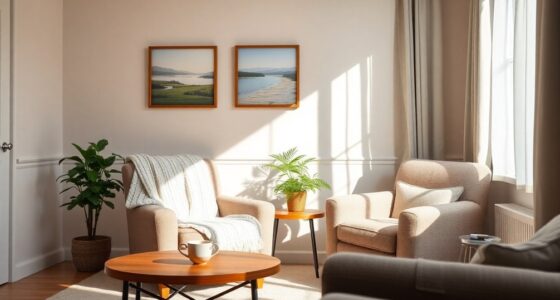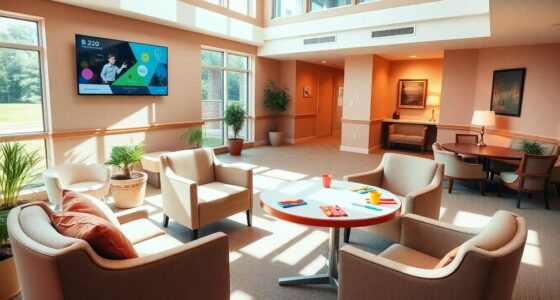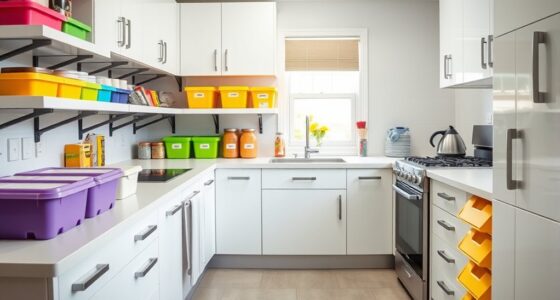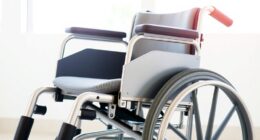To create an in-law apartment that meets medical needs without feeling clinical, focus on warm lighting, cozy furniture, and personal touches like photos or artwork. Use soft tones and textures to evoke comfort, and incorporate familiar items from previous homes. Guarantee safety features like grab bars are discreetly integrated while keeping pathways clear. Balancing practicality with homey decor helps foster independence and relaxation, and you’ll discover more ideas on blending medical functionality with comfort in the next sections.
Key Takeaways
- Incorporate warm tones, soft lighting, and cozy furniture to create a home-like, inviting atmosphere.
- Use personalized decor, photographs, and familiar items to foster comfort and a sense of belonging.
- Ensure accessibility features like grab bars and non-slip mats are discreetly integrated into warm, homely design.
- Maximize natural light with airy curtains and layered lighting to enhance ambiance without clinical brightness.
- Design with practical layout elements—such as accessible bathrooms and clear pathways—that blend safety with a warm, personalized environment.
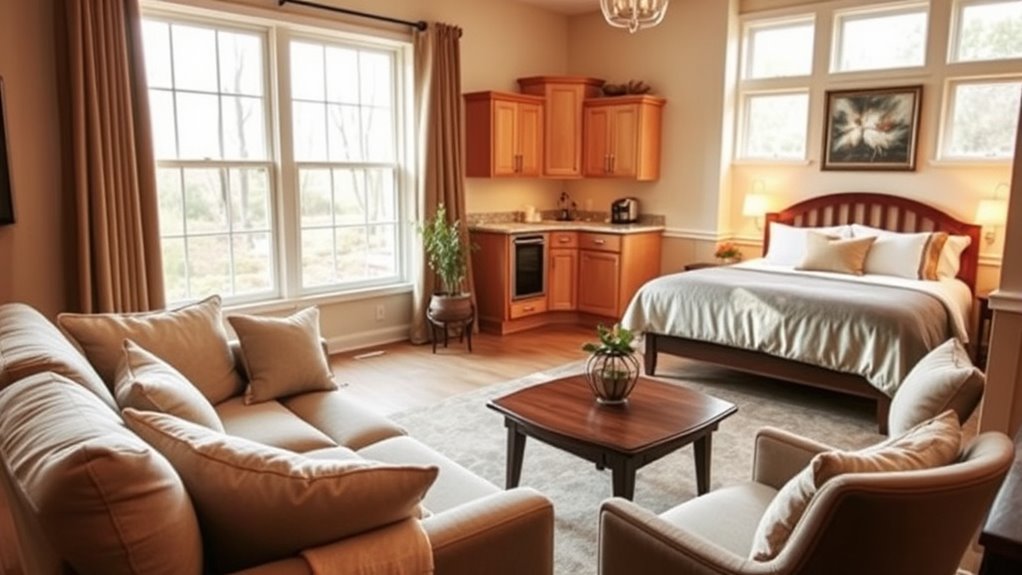
When caring for a loved one with medical needs, having a separate living space can make a significant difference. It offers both independence for your loved one and peace of mind for you. An in-law apartment provides a private area where they can regain some autonomy while still being close enough for support. The key is to create a space that feels comfortable and inviting, not clinical or sterile. You want your loved one to feel at home, not like they’re living in a hospital.
Start by choosing design elements that promote warmth and familiarity. Use soft lighting, cozy furniture, and personal touches like photographs or artwork. Avoid overly bright fluorescents or institutional decor that can make the space feel cold. Instead, opt for warm tones and textures that evoke comfort. Incorporate familiar items from their previous home or favorite colors to make the space feel like an extension of their personality. This helps reduce feelings of displacement or dependence, making it easier for them to settle in.
Choose warm tones, soft lighting, and personal touches to make your loved one’s space inviting and comforting.
Functionality is essential, but it shouldn’t come at the expense of style. When planning the layout, guarantee the essentials—like a comfortable bed, accessible bathroom, and space for medical equipment—are thoughtfully integrated. Use furniture that’s easy to get in and out of, and keep pathways clear to prevent accidents. Consider installing grab bars and non-slip mats discreetly so that safety features don’t dominate the aesthetics. The goal is to blend practicality with a homey atmosphere, so your loved one feels relaxed rather than like they’re in a medical setting.
Lighting is another vital element. Natural light can lift spirits and make a space feel more open. Maximize windows with light, airy curtains, and add layered lighting options like lamps and sconces to create a warm ambiance during the evening. Avoid harsh, direct lighting that can feel impersonal or uncomfortable. Soft, adjustable lighting options help in creating a cozy environment that feels less clinical. Additionally, understanding how to maximize natural light can significantly enhance the comfort and ambiance of the space.
Finally, think about privacy and personalization. Provide space for your loved one to keep personal belongings and hobbies. A small desk or shelf for books, crafts, or personal mementos can make a big difference, helping them feel more in control of their environment. Remember, the goal isn’t just to meet medical needs but to foster a sense of normalcy and dignity. When you combine thoughtful design with practical features, your loved one will enjoy a space that’s both functional and truly feels like home.
Frequently Asked Questions
How Can I Finance an In-Law Apartment for Medical Needs?
You can finance an in-law apartment for medical needs through various options. Start by exploring home equity loans or lines of credit, which often offer favorable rates. You might also consider grants or special programs for medical-related housing upgrades. If you qualify, Medicaid or local assistance programs could provide funding. Additionally, check with your bank or credit union for personalized loan options that suit your financial situation.
Are There Legal Restrictions on Building In-Law Apartments?
Yes, there are legal restrictions on building in-law apartments. You need to check local zoning laws and building codes because these vary by city and neighborhood. Some areas require permits, specific sizes, or setback distances. You might also face restrictions related to parking or utility connections. To avoid issues, consult your local planning department or a legal expert before starting your project, ensuring it complies with all regulations.
What Are the Best Interior Design Tips for a Non-Clinical Feel?
Your space can feel like a cozy home, not a medical clinic. Use warm colors and soft textures to create a welcoming atmosphere. Incorporate personal touches like artwork and plants to add character. Opt for furniture with rounded edges and avoid harsh lighting. Keep clutter minimal and use storage wisely. These small changes make a huge difference, transforming your in-law apartment into a warm, inviting retreat that truly feels like home.
How Do I Ensure Privacy for Both Residents and Visitors?
You can guarantee privacy by designing separate entrances and common areas for residents and visitors. Use strategic layouts that create physical barriers like walls or curtains to provide personal space. Incorporate soundproofing for bedrooms and shared spaces. Install secure locks on doors and windows, and consider privacy screens or partitions. Regularly communicate boundaries clearly to residents and visitors, fostering a respectful environment where everyone feels comfortable and secure.
What Safety Features Are Recommended for Medical-Related In-Law Apartments?
You definitely want to install grab bars, non-slip flooring, and emergency call buttons—because nothing says “homey” like a safety net. Smoke and carbon monoxide detectors should be up-to-date, and accessible exits are a must. Consider installing motion-activated lighting and secure locks on doors and windows. These features keep everyone safe without turning your cozy space into a high-security fortress. After all, safety should be seamless and unobtrusive.
Conclusion
So, imagine transforming your space into a cozy, functional in-law apartment that meets medical needs without feeling clinical. You’re on the brink of creating a sanctuary where comfort and care intertwine seamlessly. But what if the perfect design idea is just around the corner, waiting to turn your worries into a beautiful reality? Keep exploring, because the solution you’ve been searching for might be closer than you think—ready to redefine what home truly means.
